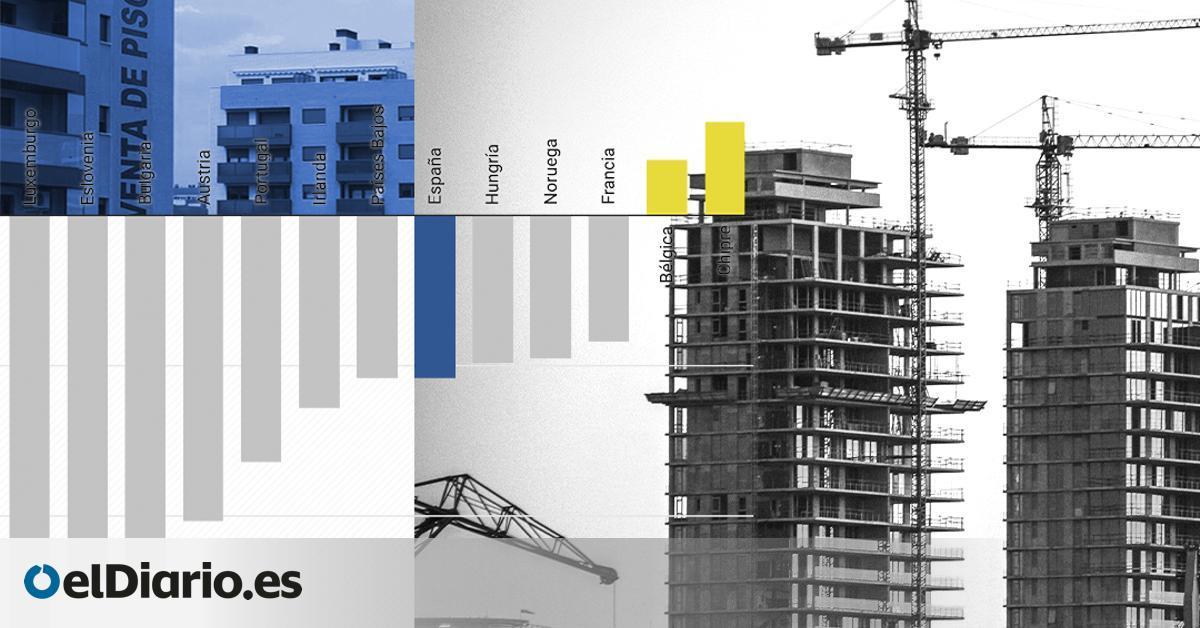
The coalition government and its parliamentary partners have managed to unblock the processing in the Congress of Deputies of the Housing Law, which had been stuck in negotiations for more than a year. A time in which the crisis caused by the war in Ukraine, the ceiling on rents and the rise in interest rates and the Euribor have changed the real estate landscape.
The Government closes an agreement with ERC and Bildu to approve the housing law
Further
We draw an X-ray of the sector in the final stretch of the approval of a regulation that, for the first time, consecrates housing as a right, aspires to give a break to the cost of rents in areas with price tension and redefines what is a great owner.
Pressure on rental prices continues
The new Housing Law puts the focus on renting, rather than on owned housing, because it is where there are more inequalities and more price pressure, especially in the so-called stressed areas, both in large capital cities and in tourist cities.
Unlike what happens with housing for sale, the statistics on the evolution of rents are not so immediate and even less complete, to know what is happening in the different territories, cities and districts, without having to resort to prices published by real estate portals. For this reason, the elaboration of the future price indices that will define the updating of rental income from 2025 will not be quick. In fact, the Minister of Social Rights and the 2030 Agenda, Ione Belarra, acknowledged on Friday that it will create a working group to design them.
Eurostat has just published data for the final stretch of 2022, which indicates that rents, on average, rose 2.5% in the fourth quarter of the year. In Spain, the general data on how the rent is going is published by the National Institute of Statistics (INE). According to his calculations, the rise in the last twelve months has been 2.1% in the country as a whole – the variation by territory is significant. According to the INE, the price increase so far this year –that is, until March– is 0.7% and only in the last month it is 0.3%. The data therefore indicates that the increases are accelerating, because at the end of February the monthly increase was 0.2% and in November 2022 it was 0.1%.
It must be remembered that almost a year ago, the Government implemented, for the first time, a ceiling on rents of 2%, as a measure to try to contain inflation and mitigate the blow to tenants, because the contracts have so far been linked to the CPI. In 2024 they will be limited to 3% and, in 2025, to that future rate still to be designed.
The high weight of rents compared to income
The Housing Law agreed upon in Congress establishes that, in order to declare an area as stressed -the autonomous communities have to do it- it is enough that “the average cost of the mortgage or rent plus basic expenses and supplies exceeds the 30% of the median household income”. That pressure, on many occasions, is higher.
The Survey of Essential Characteristics of the Population and Housing (ECEPOV) published at the beginning of the year by the INE shows that there are at least 481,000 households that spend more than 40% of their net income to pay rent. This figure corresponds to 16% of households that live for rent. But there are variations based on income, as can be seen in the following graph.
This survey also delves into the fact that the tendency to live for rent has increased since the worst years of the last great financial crisis. It has gone from 13.5% to 15.9% in the past financial year.
Also, that the weight of the rent is different depending on the territories. In the three communities where it has more weight is in Illes Balears, Catalunya and Canarias. On the other hand, the ownership of homes already fully paid for has a greater relative weight in the Basque Country, La Rioja and Castilla y León, as shown below.
Where do you live more for rent and where is there more housing purchased?
Percentage of households in each municipality with more than 50,000 inhabitants, or provincial capital, according to the tenure regime, in the 2021 census. Click on the buttons to see the detail.
The rise in rates is noticeable in the sale of homes
The rise in interest rates by the European Central Bank and, as a derivative, of the Euribor, have brought home sales to a halt. It is not something that has been noticed only in Spain, but is a reality in almost all of Europe. As can be seen in the following graph, 12 of the 14 countries that provide data to Eurostat note a drop in real estate transactions already in the final stretch of 2022.
Among those countries is Spain, although it is true that it is the fourth market with a less intense fall, although it is close to 11%. In other northern European countries, such as Finland or Denmark, the collapse exceeds 30%.
Unless real estate operations, a breather in prices. The INE has not yet published data for the first months of the year, but it has for the final stretch of 2022. In the fourth quarter, prices fell by 0.8%. It was the first relegation since 2020.
With this step back, the rise in house prices for the year as a whole remained at 5.5%, when three months earlier it was advancing at a rate of 7.6%. The trend can be seen in this chart.
And it continues in this 2023. The General Council of Notaries has just published the data for February, where it is indicated that 13.1% fewer homes were sold than in the same month of 2022. The granting of mortgages fell even more, by 24 ,4%.
If the data is seen by autonomous communities, only one gets rid of the fall. It only grew in Asturias, by 1.5%. The smallest falls were in Cantabria (-2.7), Castilla y León (-3.8%) and Comunitat Valenciana (5%). And the strongest, in Navarra (-29%), Illes Balears (-22.2%) and Canarias (-17.7%). In Catalonia, the drop in the second month of the year was -16.2%; and in Madrid, -15.1%.
A step back in pricing that won’t last long
In this property real estate market, the combination of factors to push down both prices and home sales is perceived, for example, by BBVA Research. This entity points out in a report published this Friday that “the effect of the increase in interest rates is being particularly important in the real estate market, where there is a reduction in sales, in the number of mortgages and in the price of housing , which have shown a change in trend in the second half of the year despite the restriction that can be seen in the supply of new homes”, he assures in reference to 2022.
This trend is expected to continue. “Housing transactions are expected to fall by around 30% in 2023. Although the adjustment will be significant, sales will be somewhat above 500,000, a level similar to the annual average between 2015-2019,” says Caixabank Research. “This is explained by the lower economic growth, both national and foreign, the rise in interest rates and the reduction in savings accumulated during the pandemic. The greatest adjustment will be concentrated in used housing, ”he argues.
But the puncture believes that it will not last long. “The sector could begin to show a new revival in 2024 with moderate increases in demand, supply and prices, after this year’s adjustment and the recovery of the economy, in a context of reduced supply”, predicts this analysis firm. “Thus, house prices are expected to grow around 2.5%” and “sales around 5%” over the next year. with some nuance “All this with the permission of the main risks that threaten the sector: additional monetary tightening as a result of high inflation, a shortage of qualified labor and developable land, as well as an increase in uncertainty regarding economic policy.”
The unknown of how many big forks there are
The text agreed this Friday establishes that, as of 2025, a future price index will be applied to the large owners of flats located in stressed areas, which will be the one that will define the rents paid by the tenants who live in their properties.
These large owners are those individuals or legal entities that own more than 5 homes and have them rented out.
As of today, according to the Ministry of Transport, Mobility and Urban Agenda, 85% of the owners are individuals and 15% are legal entities. And according to the statistics of this Ministry, in Spain there were more than 25.9 million properties -with data from 2021- of which more than 6.4 million do not constitute the main residence of their owners.
The previous text, the bill that reached Congress, set the limit to be a large holder in 10 homes, but it only applied to legal persons, companies. Now, with this definition change, the Ministry does not reveal, for the moment, how many houses are in the hands of these holders of more than five floors or houses.
Between 2015 and 2019, one in three homes registered in Spain corresponded to these large owners. According to data from the Cadastre, which depends on the Ministry of Finance, there are 842,000 owners with 5 or more urban cadastral assets (homes or other types of assets) and 140,000 legal entities (companies) that have 5 or more assets, without specifying whether these are 6 or more.
The problem of evictions continues, although they are somewhat less
Evictions are still a reality although it is true that they have decreased in number. In 2022, they were reduced by 7.5%, but there were more than 38,200, more than 100 per day, according to data published by the General Council of the Judiciary (CGPJ).
Almost 72% of those evictions, more than 27,500, were the result of non-payment of rent. While more than 22.2% derived from non-payment of mortgages. The former fell 5% and the latter, almost 16%, according to data from the CGPJ. Meanwhile, procedures for illegal occupation of homes fell by 20%, since about 2,750 were registered.
By province, 22.4% of the processes were carried out in Catalonia, with 8,574 evictions. Behind, Andalusia, with 6,717; the Valencian Community, with 5,594, and Madrid, with 3,679 launches.
The new Law does not prevent them, nor prohibits them, as claimed by the associations that defend those affected, but it does try to patch up the search for alternatives. Specifically, as pointed out by EH Bildu and ERC, the two parliamentary forces that have agreed with the Government, “new extensions are included in the launch procedures, which will postpone the processes for more than 2 years, and mandatory access to the procedures is stipulated out-of-court solutions for vulnerable people”. The underlying problem is the lack of an alternative due to the lack of public social housing, which represents only 2% of the total number of properties, which makes it difficult to provide a housing alternative for the evicted.
Source: www.eldiario.es
